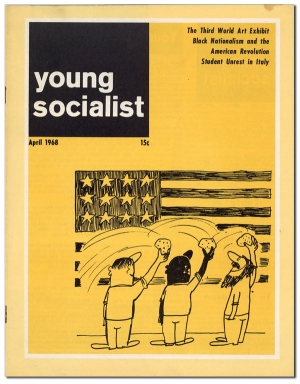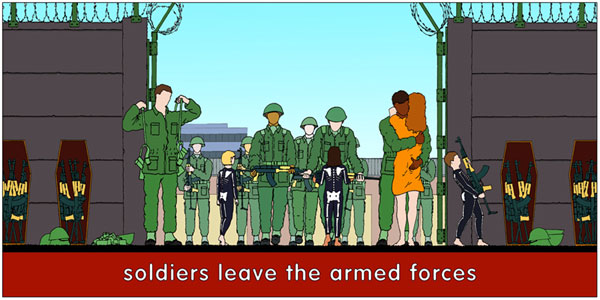
Thou Shalt Teach Revolution
Jane Rosen writes about revolutionary children’s literature, based on the recent book she co-edited with Kimberley Reynolds and Michael Rosen, Reading and Rebellion: an Anthology of Radical Writing for Children, 1900-1960
Socialists in Britain, and of course elsewhere, have always looked for ways to provide children of the movement with alternative education to counter the training of a repressive state education system and mainstream publications that glorified capitalism, imperialism and war. One of the means used here was the foundation of the Socialist Sunday School movement in 1896 and its periodical Young Socialist first published in 1901. In this were published writers such as Katharine and John Bruce Glasier and FJ Gould, who with others attempted to deliver articles and stories that looked at the world differently, and encourage children to work for a fairer, more equal and socialist world.
There were criticisms of some of the articles and stories in Young Socialist with arguments over some of the allegorical fables, which had good fairies such as Love, Kindness, Service and Work and evil fairies and giants such as Capitalism and War. Some of the SSS workers and YS contributors felt that the movement was a little too prone to feeling that all including class enemies should be treated with love and kindness. Tom Anderson, revolutionary educator and writer, for example wrote in the May 1908 issue of YS that ‘We can’t save the workers by mending the present system. No, we must have “The Revolution”.’ In the editorial of June 1908, the editor responded: ‘the note which appeared on the song page of our last month’s issue entitled “The Revolution,” is in no sense an expression of the sentiment of our general School movement. Nor does it voice the official opinion of our various Unions. Our National Socialist Sunday School Movement stands for the teaching of Socialism – not Revolution….in no sense does the term revolution express our glorious ideal of Socialism. And to teach revolution is not to teach Socialism.’ The result of this disagreement was that Anderson left the SSS and set up his own school movement that was to become the Proletarian Schools with its own set of maxims of which number 5 states ‘Thou Shalt Teach Revolution.’ And teach revolution he did.
From 1914 he began publishing parables, songs and radical biographies for use in the Proletarian Schools and for the general revolutionary education of children. Anderson also published periodicals – three of them. The first Revolution began in June/July 1917 and lasted a year. During its time it featured a serial story about the experiences of a Russian girl revolutionary at the time of the 1905 Revolution by the Latvian émigré, Tolstoyan, member of the Russian Social Democratic Labour Party, and translator of Lenin, Alexander Sirnis. The journal was probably closed because of its last article ‘Don’t Shoot Your Class’. His last periodical Proletcult began in March 1922 and featured stories by Sylvia Pankhurst and Herminiya Zur Mühlen. Sylvia’s work here is fairly pedestrian but Zur Mühlen’s is remarkable, described by Anderson as ‘the kind of lessons which interest the child mind.’
Though there were certainly other radical publications for children, a significant step was the foundation of Martin Lawrence (later Lawrence and Wishart) in 1927 and the appearance of what appears to be their first children’s book in 1931, the annual The Red Corner Book for Children. Contributors included Zur Mühlen again, and the historian TA Jackson, as well as American and Soviet contributions. Perhaps the most important thing that Martin Lawrence did for British children’s literature in general was to start a collaboration with the then unknown Geoffrey Trease. In the period 1934-1937 they published five of his books, including his first book, a Marxist retelling of the Robin Hood legend Bows Against the Barons (1934). Although Trease was to move to another more commercial publisher and to become one of the best well-known writers of children’s historical fiction, he remembered his time with Martin Lawrence with affection.
Martin Lawrence also published a children’s biography of Lenin by Ruth Shaw and Harry Alan Potamkin, with drawings by William Siegel, a Jack Lindsay story set in the Australian goldmines, another annual, two volumes of fairy tales by F and Ida Le Gros Clark, and the wonderful Eddie and the Gypsy by Alex Wedding, which had originally been published in Germany by Wieland Herzfelde’s Malik Verlag and was illustrated with photographs by John Heartfield. It this book, perhaps, in spite of the good story telling and future success of Geoffrey Trease, that was the best of the children’s works published by Martin Lawrence. It is an adventure story set in working-class Berlin in the 1930s during the period of unrest that preceded the success of the National Socialist Party in 1933. It sparkles whilst it teaches revolutionary politics and it champions acceptance of the other through the friendship between Eddie, the main protagonist, and Unku, the Sinti girl who befriends him. Heartfield’s photographs record a Sinti community that was to be decimated in the years that followed. Of the eleven Sinti children mentioned in the book and recorded in the photographs, only one survived the Holocaust.
What happened next? The Socialist Sunday School and Young Socialist survived until the 1970s, Tom Anderson died in 1947, and the last children’s book Lawrence and Wishart published was Carpenter Investigates by Herbert L Peacock, a rather turgid set of short stories that appeared in 1950. Its most revolutionary aspect are the illustrations by Ken Sprague. There were also the translations of Soviet children’s books that were distributed here, material issued by the Daily Worker and the Woodcraft Folk and plays at Unity Theatre and Theatre Royal Stratford.
As economic and ideological conditions changed in the 1960s and 1970s there was a move to introduce more working-class protagonists and radical ideas into mainstream publishing for children with writers such as Bob Leeson, Bernard Ashley, Robert Westall, and Alan Garner coming to the fore. This phenomenon deserves a whole article to itself.
Currently material is still being published for children that is radical and worthwhile – Michael Rosen, Alan Gibbons, and Andy Croft, for example. There does, however, seem to be a rejection of more revolutionary works, and works that really celebrate the working-class, let alone working-class radicals. The Little Rebel Award, welcome though it may be, has largely been won by books produced by mainstream publishers. Mainstream publishers may produce radical books if we define radical as concerned or liberal, but it is unlikely that they will produce genuine revolutionary material. So, let us echo Geoffrey Trease writing in International Literature in 1936: ‘Where is our revolutionary literature for the children?’
Many of the authors mentioned in this article who were published before 1960 appear in Reading and Rebellion. In November last year, Kim Reynolds, Michael Rosen and I launched our book ‘Reading and Rebellion’ at the Marx Memorial Library. For many reasons this was the ideal venue, not least because of the Library’s link with Alex Gossip, the author of the first extract in the book, and a former President of the Library, and the fact that they hold many of the titles that appear in our book. Amongst these are pamphlets and periodicals by Tom Anderson and to give an idea of what revolutionary writing for young people can look like, Culture Matters is republishing ‘Don’t Shoot Your Class!’ It may well become obvious why this was the last issue of Revolution, as it was likely to have fallen foul of the Defence of the Realm Act, leading to its demise.
'Don't Shoot Your Class!' is republished here. Where, indeed, can we find revolutionary literature for our children? If you are interested in writing, illustrating or helping to produce some new revolutionary literature for children, please contact us at This email address is being protected from spambots. You need JavaScript enabled to view it.. Reading and Rebellion: an Anthology of Radical Writing for Children, 1900-1960, by Jane Rosen, Kimberley Reynolds and Michael Rosen, is published by OUP at £25.



